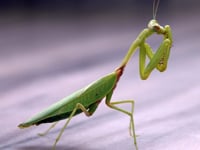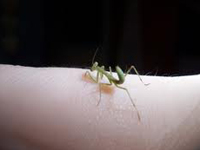

 |

|
 Praying Mantis |
Praying Mantis(Insect) |
 Praying Mantis Baby |
Praying Mantis HabitsThere are nearly 2,000 species widely distributed throughout tropical, subtropical, and warm climate area of the world. Found in a variety of habitats including deserts, meadows, and savannahs all through the warmer parts of the world, especially in the humid tropical rainforest, where the majority of species occur.
Mantises have a number of enemies, particularly birds. In order to discourage them, large mantises will strike out with their spiny forelegs. Other species, not large enough to frighten an enemy in this way, seek to discourage an aggressor by suddenly exposing brightly colored wings, which often have false eye-spots to give the impression of a frighteningly aggressive face. Such tactics are only necessary when the mantis has actually been seen. The first line of defense is to avoid detection at all. Most mantises are therefore well camouflaged for its survival, to avoid been eaten by birds. Grass-dwellers tend to be green, and tree-dwellers are often mottled brown. |
Praying Mantis CommunicationMantises communication is accomplished chiefly through tactile, environmental and chemical channels. They are sensitive to any changes in vibration or pheromones among their population, and these changes can make all the difference in their ability to procreate and stay alive. |
Praying Mantis BreedingThe female praying mantis widely known for her particular habit of biting the head off her partner while they are mating. This cannibalistic act was once believed to be a regular practice. However, it now seems likely that it is much rarer in female mantises in the wild than in captive mantises kept in a cage.
After mating, the female lays, her eggs in batches enclosed in a tough, spongy envelope called an ootheca. The ootheca is attached to fence posts, twigs, stems, or sometimes buried in the ground. The females of some species of mantis stand guard over their eggs until the young emerge. They fend off attacks by parasitic wasps which lay their eggs in the eggs of the mantis. The eggs hatch 3 weeks to 6 months after being laid. The young emerge from the eggs through tiny holes in the ootheca. Many species of mantises resemble ants when they are small, but as they go through a series of molts (shed their skin), they begin to look more like a adult mantises. |
Praying Mantis Food & FeedingMantis are carnivorous insects that takes up a deceptively humble posture when it is searching for food. Praying mantises do not actively hunt down their prey. Instead, they wait unmoving and virtually invisible on a leaf or stem, ready to seize any passing insect. When potential prey comes within range, the mantis thrust its pincer like forelegs forward to grasp the insect. Any chance of escape is minimized by the viselike grip facilitated by the rows of hooked spines along the inner part of the mantis' front legs. The mantis bites its prey's head off first. |
Praying Mantis Key Facts |
| Size |
| Height: Length: Varies from 1/2-12 in., according to species |
| Weight: About 6 ounces |
| Breeding |
| Sexual maturity: 3 months |
| Mating: Summer in temperature areas. Years-round in the tropics. Elsewhere during the wet season |
| Gestation: Hatching: 3 weeks-6 months, depending on temperature and humidity |
| Number of young: Eggs: 10-400 |
| Lifestyle |
| Habit: Solitary |
| Diet: Other insects and spiders. Large species will also eat frogs, lizards, and nestling birds |
| Lifespan: Maximum of 1 year in the wild |
DID YOU KNOW?
|
CAN'T FIND WHAT YOU'RE LOOKING FOR? CLICK HERE!!!